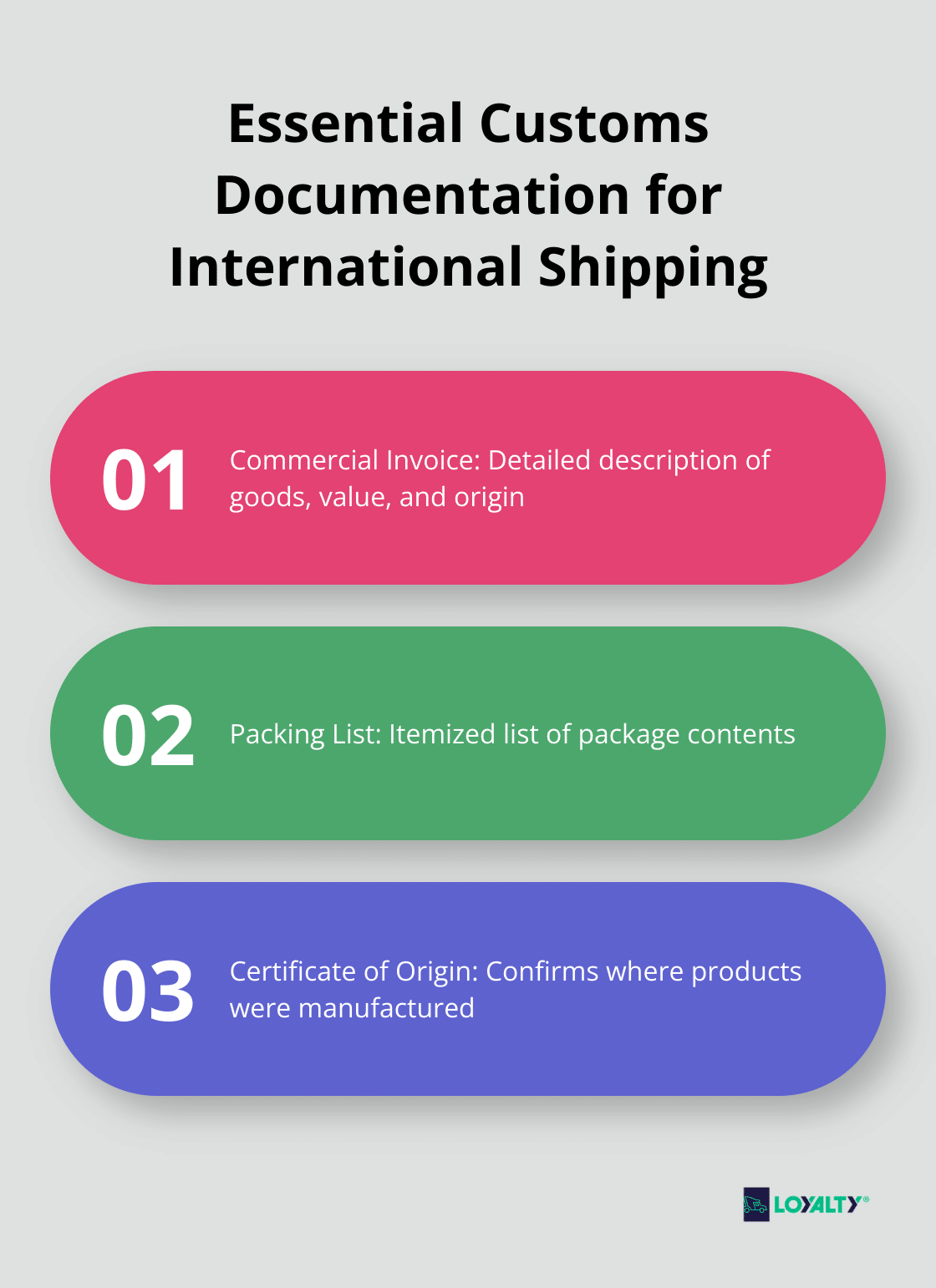Cross-border shipping presents a maze of challenges for businesses expanding internationally. From complex regulations to cultural differences, the obstacles can seem overwhelming.
At Loyalty Logistics, we’ve helped countless companies navigate these hurdles successfully. This guide will equip you with practical strategies to overcome the most common issues in shipping cross border, ensuring your global operations run smoothly.
Key Cross-Border Shipping Regulations
Customs Documentation: Your Passport to Smooth Shipping
Cross-border shipping regulations form a complex landscape that businesses must navigate. Accurate and complete customs documentation stands as the cornerstone of successful international operations. The commercial invoice is required for all international commodity shipments with commercial value. It must contain a detailed description of the goods, their value, and the country of origin. Errors in this document can result in delays, fines, or even shipment rejection.

Other essential documents include the packing list, certificate of origin, and specific certifications or licenses (depending on the goods and destination). Food products, for instance, often require additional health certificates.
Digital tools can automate and standardize your documentation process. This approach significantly reduces errors and accelerates customs clearance.
Tariffs and Duties: The Hidden Costs of International Trade
Tariffs and duties can have a substantial impact on your bottom line. These charges vary widely based on the type of goods, their value, and the countries involved in the transaction.
The U.S.-Mexico-Canada Agreement (USMCA) has reshaped the tariff landscape for North American trade. Under this agreement, many goods can now move duty-free between these countries, provided they meet specific rules of origin.
To avoid surprises, research the applicable tariffs and duties before shipping. Consider working with a customs broker who can provide up-to-date information and help you classify your goods correctly.
Compliance: Staying on the Right Side of International Law
Compliance with international trade laws extends beyond paying the right tariffs. You must be aware of restricted or prohibited items, embargoes, and sanctions.
The U.S., for example, enforces strict regulations on the export of certain technologies that could have military applications. Violating these rules (even unintentionally) can result in severe penalties.
Stay informed about changes in trade regulations. Government websites like the U.S. International Trade Administration or Canada Border Services Agency serve as excellent resources. However, given the complexity of these laws, many businesses find it beneficial to partner with logistics experts who specialize in international compliance.
As we move forward, it’s important to recognize that regulatory compliance is just one piece of the cross-border shipping puzzle. The next challenge lies in overcoming language and cultural barriers, which can be just as impactful on your international operations.
Breaking Language and Cultural Barriers
Invest in Professional Translation Services
Professional translation services are crucial for multinational companies to effectively communicate their message and maintain a positive customer experience. Accurate translations prevent significant delays at customs. For example, when you ship to Quebec, precise French translations of all documentation are essential.
Build a Multilingual Team
Team members who speak the languages of your key markets provide invaluable support. They handle real-time communication with partners, decode cultural nuances, and identify potential issues before escalation. If you can’t hire multilingual staff, a logistics provider with these language capabilities (such as Loyalty Logistics) becomes a strategic asset.
Adapt Your Communication Style
Different cultures have varying communication preferences. Some Asian countries often prefer indirect communication to maintain harmony. This preference might mean a “maybe” actually translates to “no.” Understanding these subtleties prevents misinterpretations and strengthens business relationships.
High-context cultures (like Japan or China) require attention to non-verbal cues and conversation context. Low-context cultures (like Germany or the United States) typically prefer direct, explicit communication.

Navigate Business Practices
Effective cross-cultural communication extends beyond words. It involves understanding and respecting different business practices, negotiation styles, and decision-making processes. For instance, in some cultures, business meetings start with small talk and relationship-building, while others prefer to dive straight into business matters.
Leverage Technology
While personal interaction remains important, technology can bridge communication gaps. Video conferencing tools allow for face-to-face interactions across borders. Translation apps (while not perfect) can assist in real-time communication. However, use these tools as supplements, not replacements, for human interaction and professional translation services.
The ability to navigate language and cultural barriers sets the stage for efficient logistics and transportation management. The next section will explore how to optimize your cross-border shipping methods and overcome tracking challenges.
Optimizing Cross-Border Logistics
Selecting the Right Shipping Method
Cross-border shipping requires a strategic approach to logistics and transportation management. The choice of shipping method impacts delivery times, costs, and overall efficiency. For time-sensitive shipments between the U.S. and Canada, expedited ground services often provide the best balance of speed and cost-effectiveness. Air freight becomes essential for urgent deliveries to Mexico or remote locations.
Intermodal transportation, which combines truck and rail, offers a cost-effective solution for less time-sensitive shipments. This method reduces fuel consumption and carbon emissions, aligning with growing sustainability demands. Freight rail offers a meaningful way to reduce greenhouse gas emissions. On average, railroads are approximately four times more fuel efficient than trucks.

For businesses shipping large volumes, full truckload (FTL) services maximize efficiency. However, less-than-truckload (LTL) options provide flexibility and cost savings for smaller shipments.
Enhancing Shipment Visibility
Tracking and visibility pose significant challenges in cross-border shipping. Real-time tracking systems help maintain control over shipments. GPS-enabled devices and IoT sensors provide continuous updates on location, temperature, and handling conditions.
Electronic Data Interchange (EDI) systems facilitate seamless information exchange between shippers, carriers, and customs authorities. This technology reduces paperwork, minimizes errors, and accelerates customs clearance processes.
Blockchain technology creates an immutable record of each transaction and movement, enhancing transparency and trust. Major retailers have implemented blockchain to track food products across borders, reducing traceability time from days to seconds.
Reducing Transit Times and Costs
Efficient cross-border shipping minimizes delays and expenses. Participation in trusted trader programs like C-TPAT (Customs-Trade Partnership Against Terrorism) in the U.S. or PIP (Partners in Protection) in Canada can expedite border crossings and reduce inspection times.
Consolidation of shipments reduces per-unit shipping costs. This strategy works particularly well for businesses with regular, smaller shipments to the same destination.
Free trade agreements like USMCA can significantly reduce or eliminate duties on qualifying goods. However, these agreements require expertise to navigate. Working with knowledgeable logistics partners ensures maximum benefits without violating complex rules of origin.
Proper packaging and labeling prevent damage and delays. High-quality materials and clear, accurate labels (compliant with destination country requirements) can prevent costly returns and customs holds.
Nearshoring strategies reduce transportation distances and costs. Moving production closer to end markets cuts shipping expenses and improves supply chain resilience. A Gartner study found that 33% of companies were moving their sourcing and manufacturing activities out of China (or planning to do so by 2023), with Mexico often cited as a preferred alternative.
Final Thoughts
Cross-border shipping presents a complex landscape of challenges. Businesses must adapt their strategies to remain competitive in the international marketplace. Success in shipping across borders requires understanding and addressing regulatory compliance, language barriers, and logistics management.
Partnerships with experienced logistics providers offer access to specialized knowledge and advanced technologies. Loyalty Logistics provides versatile transportation solutions across North America. We deliver timely, damage-free shipments with a high on-time rate.
The future of international trade and shipping holds both opportunities and challenges. Technological advancements promise greater transparency and efficiency in supply chains. Sustainability concerns drive innovations in eco-friendly shipping practices (such as our Loyalty Green Rewards program).


